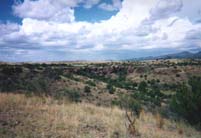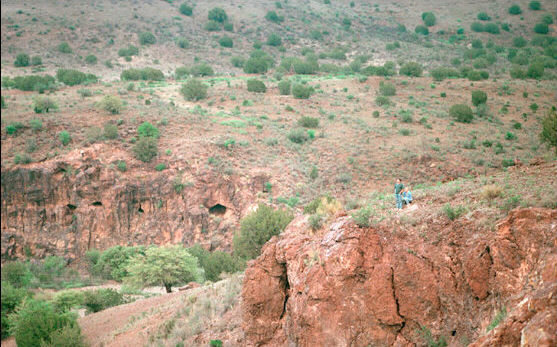BRIEF GEOLOGICAL DESCRIPTION OF THE WOODWARD RANCH AREA
Even though there have been several separately identified volcanic extrusions in the southern Davis Mountains area of west Texas, there is only one formation which is the true source of the famous Woodward Ranch Red Plume agates. This formation consists of seven separately identified lava flows. Geologically, the overall area consists of a series of lava flows which, over an extended period of time, deposited several layers of lava and ash material throughout the Davis Mountains area in the Trans-Pecos region of west Texas.
Beginning about 35 million years ago (MYA) from the Upper Eocene - Late Oligocene(?), and throughout the later Tertiary age, much of these lava and ash volcanic activities were likely coincidental to the Rocky Mountain Orogenic Uplift.

Fig.1 Box canyon capped by Lower Tertiary volcanic flow.
Mount Ord is seen in the background.
Some of these lava flows contained gases which generated the gas pockets in which subsequently downward-moving silica-bearing, low-temperature ground water deposited the agates as a silica gel. This gel in each cavity, or gas pocket, when reacting with the particular chemicals and minerals in the cavity lava walls touching it, upon solidification, determined which of the varieties of agate would develop in that particular gas pocket or cavity.
Some of the agates found are Red Plume, Black Plume, Golden Yellow Plume, Carnelian, Banded, Moss, Jaspers, or one of most all of the many types and kinds of agate found anywhere else world-wide. As each lava has a slightly different chemical content, the agate found in each lava flow, if any at all, is more or less distinctive of that particular lava flow.
Considerable erosion took place between many of these various eruptions which created many gaps in the lava flows. One reason why one can find agates on some hills and directly across the canyon, or draw, there are none: the two hills simply aren't from the same lava flow. Another reason is the adjacent flow may have been a part of the same flow, but was not beneath the lake waters at that time, or local environmental conditions were not present for agate deposition due to lack of silica-bearing waters not being able to get into the formation for some reason such as an impermeable barrier. Thus, it was not subject to the particular chemicals and minerals required for the deposition of the silica gel necessary for the forming of agates. The lavas that produced these gemstones are up to 750 feet thick in some places and are exposed over approximately 3,000 acres.

Fig.2 Bluff at the campgrounds.
Gem quality Labradorite crystallized in only one of the lavas while the lava was still deep within the magma chamber of the volcano. It was subsequently carried out in the lava extrusions as large crystals up to six inches in length. These facet-quality stones can usually be found in eroded pockets or loose in the eroded soil from the flow.
(T.R.Woodward, 12/2002)
REFERENCES:,
Correlation of Tertiary Rock Units, West Texas, Ross A. Maxwell and John W. Dietrich, Bureau of Economic Geology, Report of Investigation - No. 70, Austin, Texas, December 1970
Geology of Cathedral Mountain Quadrangle, Brewster County, Texas, William N. McAnulty, Bureau of Econimic Geology, Report of Investigation - No. 25, Austin, Texas, May 1955
Return to ROCK HUNTING
Return to the HISTORICAL INTERESTS page

© Tommy R. Woodward
All rights reserved.